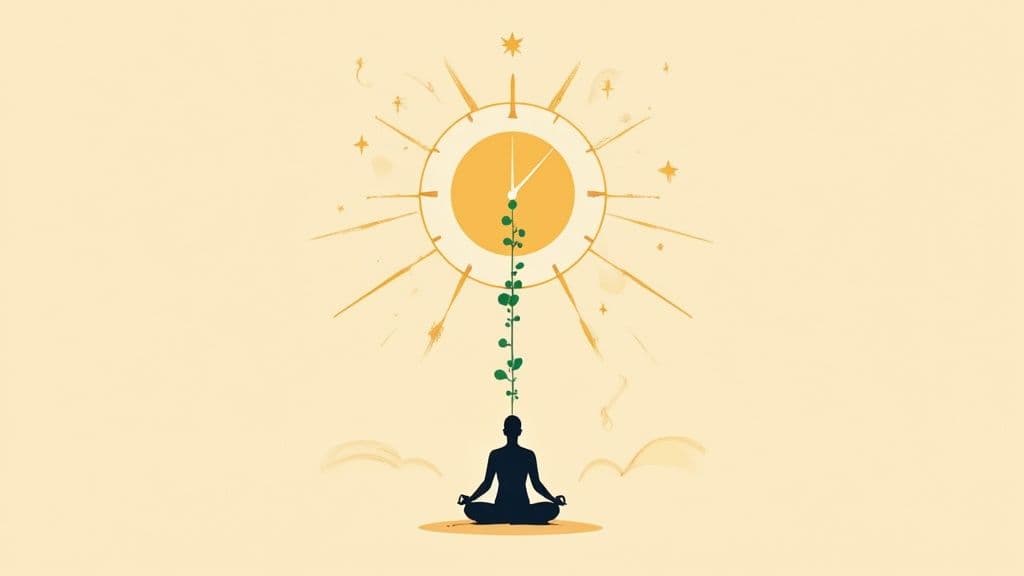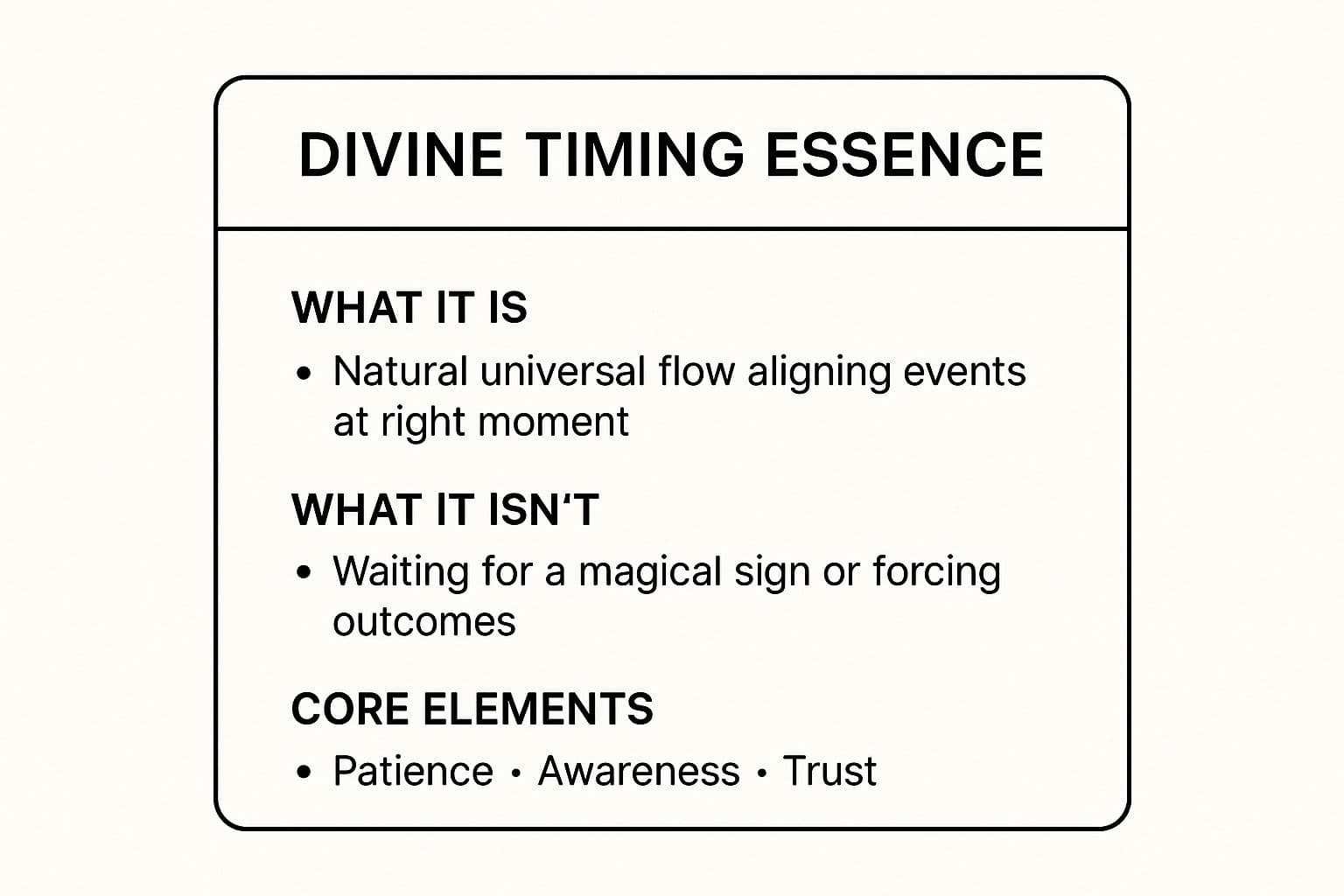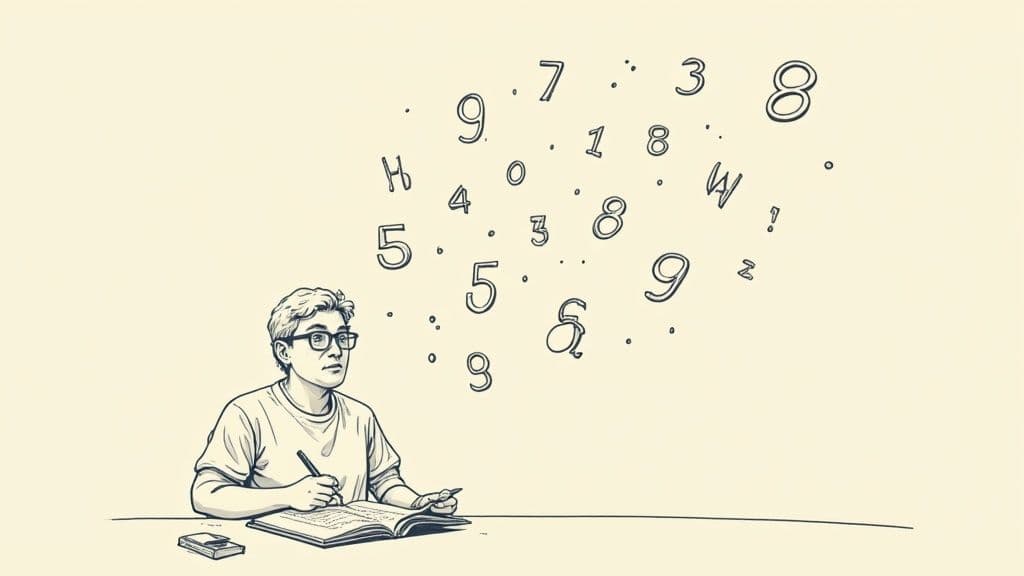Divine timing is the sense that events unfold at the right moment for your growth. Learn how to spot the signs, take purposeful action, and build trust so you can move with your life’s natural rhythm.
October 13, 2025 (1mo ago) — last updated October 29, 2025 (26d ago)
Divine Timing: How to Recognize & Use It
Learn how to recognize divine timing, spot its signs, trust the process, and align with your life path for greater meaning and growth.
← Back to blog
Divine Timing: How to Recognize & Use It
Summary: What is divine timing? Learn to recognize the signs, trust the universe, and align with your life’s true rhythm for deeper meaning and fulfillment.
Introduction
Divine timing is the sense that events unfold at the right moment for your growth, not always when you want them, but when you need them. This article explains how to spot the signs, take purposeful action, and build the trust needed to move with your life’s natural rhythm.

Understanding the true meaning of divine timing
Have you ever pushed against a closed door and felt only resistance, then watched a different door swing open when you let go? That’s divine timing.
This isn’t passive waiting. It’s active: cultivating patience, sharpening awareness, and trusting a rhythm larger than your personal timeline. Think of planting a garden—you prepare the soil and water the seed, but the seed sprouts on its own schedule. Forcing it only damages the process.
What divine timing is—and what it isn’t
It’s easy to mistake divine timing for an excuse to do nothing or for rigid fate. In reality, divine timing is collaborative. Your intention and effort are the seeds; the universe supplies sun and rain when conditions are right.
The core idea is to find peace in the unfolding of your life, trusting that what is meant for you will not miss you, and what misses you was never meant for you.
| Core Principle | What It Is | What It Isn’t |
|---|---|---|
| Patience | Trusting the process and allowing things to unfold naturally. | Impatiently waiting for a specific outcome on your schedule. |
| Action | Taking inspired action and preparing for opportunities. | Passively waiting for things to happen to you. |
| Trust | Having faith in a larger plan, even when you can’t see it. | A belief in a rigid, unchangeable fate. |
| Alignment | Co-creating with the universe; your effort meets opportunity. | An excuse for inaction or giving up control. |
This partnership between your effort and universal support is what makes divine timing practical and empowering.
Recognizing divine timing in daily life

Divine timing usually appears as subtle nudges rather than dramatic signs. One common indicator is synchronicity—those meaningful coincidences that seem too perfect to be random. Ever think of someone you haven’t spoken to for years, then get a call from them minutes later? Those moments can feel like gentle confirmations that you’re aligned. Carl Jung coined the term synchronicity to describe such meaningful coincidences1.
Interpreting detours and closed doors
Sometimes divine timing shows up as a closed door—a job you didn’t get or a relationship that ends. Seen through this lens, setbacks are often protection or redirection rather than failure. Many people look back and realize that a missed opportunity created space for something better.
Tools to cultivate awareness
Recognizing these signs takes a quiet mind and an open heart. Practical tools include:
- Journaling for patterns: Track synchronicities, coincidences, and strong gut feelings. Over time patterns emerge.
- Practicing mindfulness: A daily mindfulness habit keeps you grounded in the present, which is where signs appear. Research shows mindfulness programs reduce anxiety and improve emotional regulation2.
By using these tools, you can begin to see your life as a coherent path rather than random events.
Historical moments that feel divinely guided

On a grand scale, people have long seen certain historical twists as evidence of a larger design. Examples include natural events that dramatically changed outcomes in warfare and exploration.
The Mongol invasions of Japan in 1274 and 1281 were thwarted by powerful storms later called “kamikaze,” or divine winds3. During the American Revolution, an unexpectedly dense fog helped George Washington evacuate troops at Long Island, a moment many contemporaries saw as providential4. These stories illustrate how weather and circumstance have shifted history in ways people interpret as timely intervention.
These moments aren’t proof of a plan, but they show that timing matters and that people commonly look for meaning when events align perfectly.
Finding your personal rhythm and life path

Divine timing becomes most useful when applied to your life. Dan Millman’s book, The Life You Were Born to Live, offers a practical system for discovering a life path number using your birth date5. That number can clarify recurring patterns, innate strengths, and the lessons you’re likely to face.
Knowing your life path helps you align effort with timing. It’s not about predicting exact events; it’s about understanding your internal rhythm so you know when to push forward and when to wait.
The art of surrender and trusting the process
Surrender doesn’t mean giving up. It’s a conscious choice to loosen control over how and when things should happen. Instead of asking, “Why isn’t this happening yet?” try asking, “What is this waiting period teaching me?”
How to build trust when impatience wins
Trusting the process is a skill. Start small:
- Mindful moments: Even a few minutes of focused breathing calms the part of your brain that obsesses about outcomes.
- Simple affirmations: Try repeating, “I am exactly where I need to be,” or “I trust the timing of my life.”
- Get grounded: When anxiety rises, notice sounds, sights, and the feeling of your feet on the floor. Anchoring in the present restores perspective.
Surrender creates inner space to hear your intuition. When you stop micromanaging every detail, your inner guidance becomes clearer and you’re better positioned to recognize timely opportunities. For practical tips on strengthening intuition, see our guide on how to improve your intuition.
How divine timing shapes spiritual growth
Belief in a larger timing has guided spiritual traditions for centuries. Seeing personal events as part of a bigger pattern helps many people find comfort and purpose. When we connect our experience to this broader view, personal losses and gains become parts of a long story rather than isolated incidents.
Modern spiritual organizations also reference timing when making major decisions, treating readiness and alignment as essential to success. For example, leaders of The Church of Jesus Christ of Latter-day Saints described the rapid temple expansion in the late 1990s as guided by divine timing.6
When we connect our personal experiences to a larger spiritual context, we realize our journey isn’t happening in isolation.
Answering common questions about divine timing
How can I trust divine timing when I’m impatient?
Acknowledge your impatience without judgment, then reanchor in the present. Short mindfulness practices, gratitude lists, and framing delays as preparation can shift perspective and ease anxiety.
Does divine timing mean I should do nothing?
No. Divine timing is co-creation. Show up, do the work, and prepare—then be ready to act when the opportunity appears. Your consistent effort is the surfboard; timing supplies the wave.
How do I tell intuition from wishful thinking?
Track nudges in a journal and look for patterns. Genuine intuition tends to be calm and consistent rather than frantic or fear-driven. Over time, patterns reveal which inner messages reliably guide you.
Quick Q&A
Q: What is divine timing in one sentence? A: Divine timing is the idea that events occur when they best serve your growth, blending your actions with a larger, unfolding rhythm.
Q: How do I start recognizing it? A: Practice mindfulness, keep a synchronicity journal, and note recurring symbols or coincidences.
Q: What if I still feel stuck? A: Focus on small, meaningful actions, cultivate patience, and seek clarity about what you can control now.
Ready to discover your life path? The Life Purpose App brings the wisdom of The Life You Were Born to Live to your fingertips. Uncover your number, map personal cycles, and align with your true purpose at https://lifepurposeapp.com.
Discover Your Life Purpose Today!
Unlock your true potential and find your life’s purpose.
